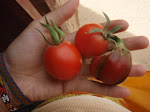Tuesday, January 6, 2009
What we eat and how it's made
In the couple of weeks that I've been home for Christmas, I've gotten a lot of questions about what I eat in Niger, and about what everybody else eats, on a normal day. The curiosity is mutual! People in my village are also keen to know what it is that we eat in the States, and I am asked about it all of the time. They guess that Americans eat a ton of meat, bread, and rice- a pretty accurate guess if you ask me! I'll try to shed some more light on the typical diet for rural Nigeriens, and also on mine.
So, first: as alluded to in previous letters, Nigeriens eat millet, every day. In my area, it is usually the only thing eaten. It comes in two main forms: as hura or as tuwo. Hura is a millet+milk=water porridge that is drunken from midmorning until night- basically, whenever you're hungry or thirsty, you take a few gulps of hura. Tuwo is a thicker millet meal that is hardier and more solid than hura; it's served with sauce made from any available ingredients (usually dried okra, dried tomato, garlic, and salt, plus any dried leaves gathered in the fields). Tuwo isn't made every day; it takes longer to prepare than hura.
The making of either hura and tuwo for a family of 10 people takes anywhere between 3 and 4 hours when the labor is shared by two or three women. A really long time. In the example of hura, you have to: 1. Carry a bundle of millet stalks from your granary to the threshing area (threshing areas are communal spaces, usually on the edge of the village, where women work together with women from other families). (10-20 minutes) 2. Beat the stalks with a stick to separate the millet from the stalks. (20-30 mins) 3. Beat the millet chaff off of the seed using a large pounder or a long stick. (20-30 mins) 4. Separate the chaff from the seed by using the wind to blow away the chaff. (20-30 mins) 5. Take the seed from the threshing area to your home. (10-15 mins) 6. Pound the seed to remove the husk. (20-30 mins) 7. Wash the husk away in water, which is then given to the animals to drink. (15-20 mins) 8. Pound the husk-less seed (the germoplasm) into a course flour. (15-20 mins) 9. Roll the coarse flour into large balls and boil them to soften them up. (15-20 mins) 10. Pound the boiled flour balls with a little bit of water until they make a solid lump of dough. (10-15 min) 11. Mash the dough in a bowl of cow's milk, add water and hot pepper, and voila! It's ready.
The sound of millet being pounded is a constant one; I can hear it before the sun comes up every morning. I'm sure you wonder what it actually looks like, so here's some video of Zuera and Mariama .
Subscribe to:
Post Comments (Atom)








2 comments:
When its my turn to make dinner next time, I promise not to complain.
Very interesting and informative post. This has to be an amazing experience for you!
What an extremely interestin post! I love the colourful costumes of those industrious women! They do work hard to provide food for their families.
Thankyou so much for visiting my blog, & leaving me a comment. I have really enjoyed meeting you.
Post a Comment